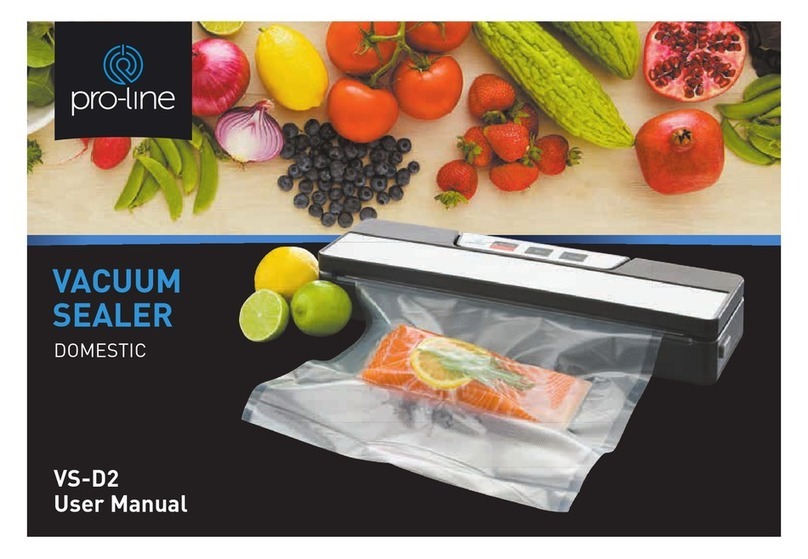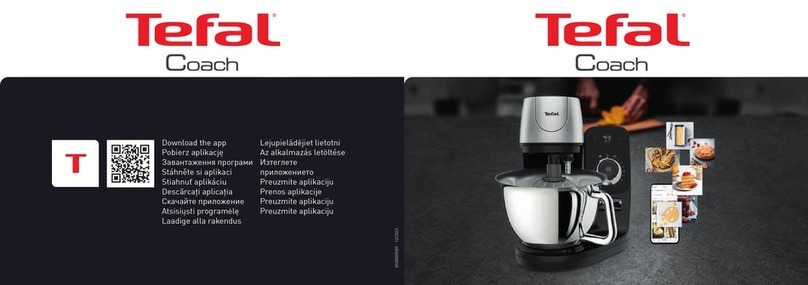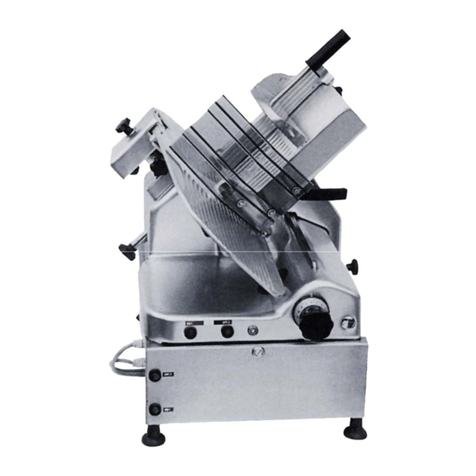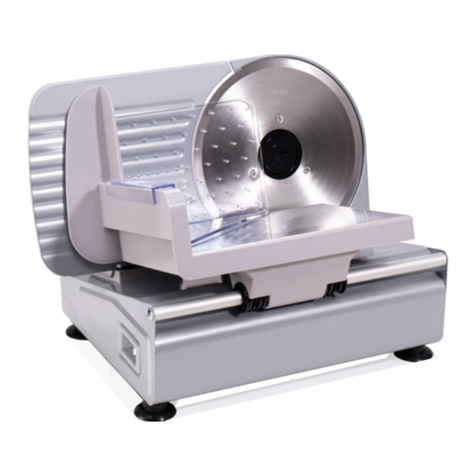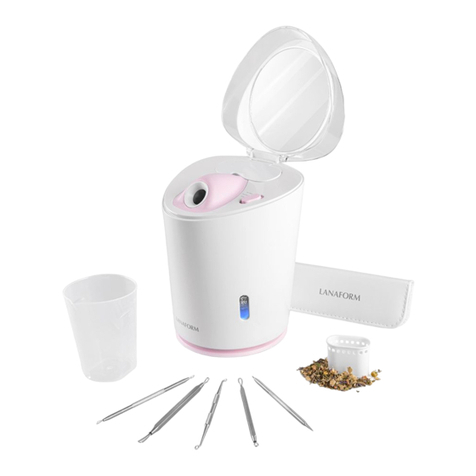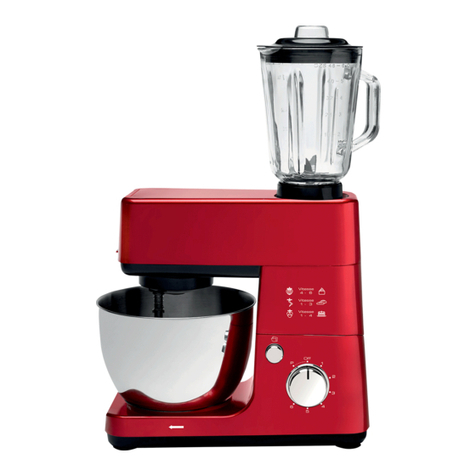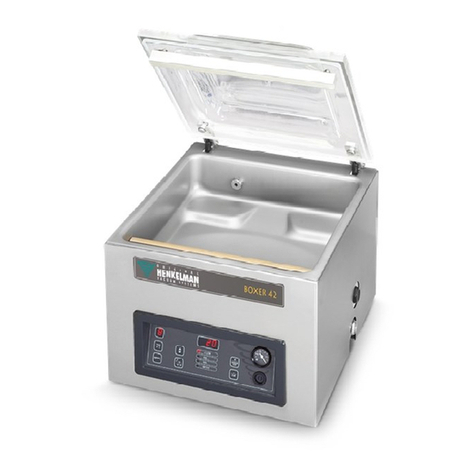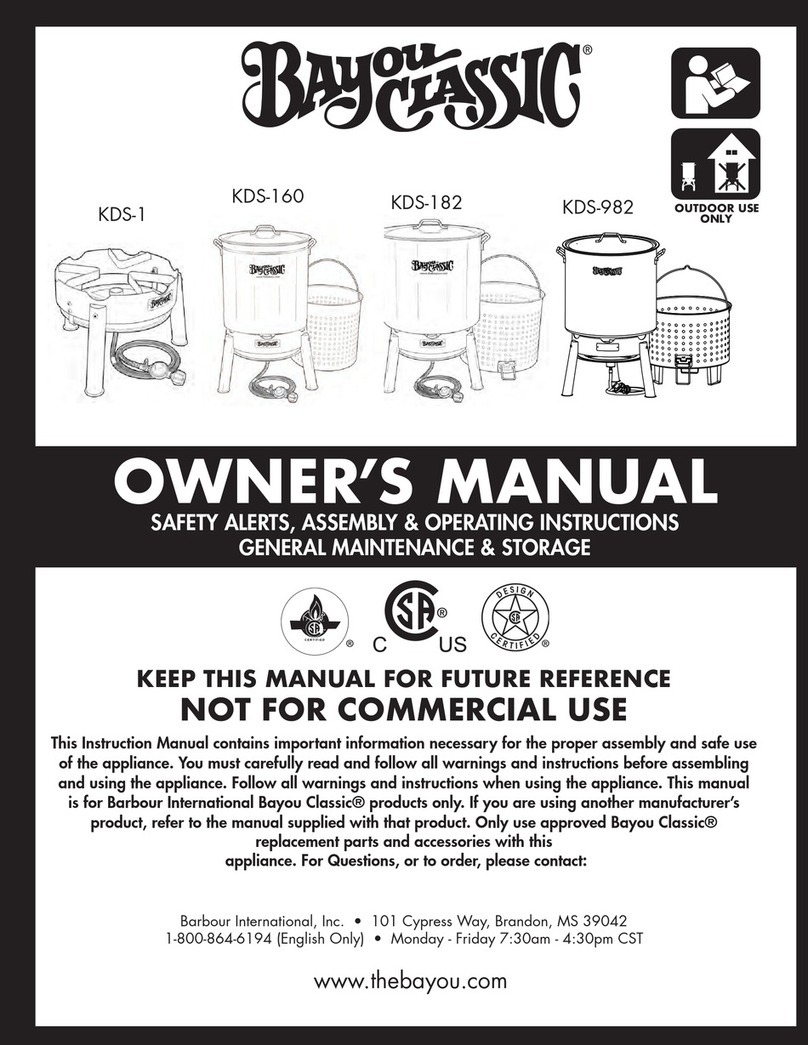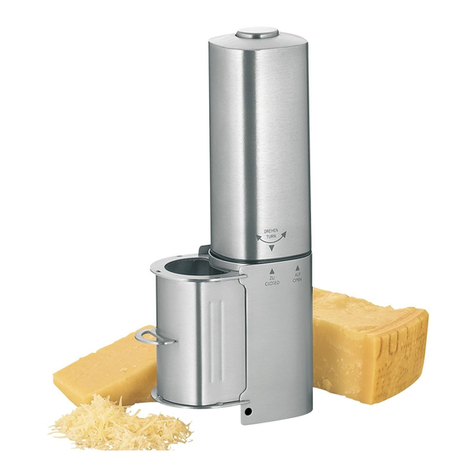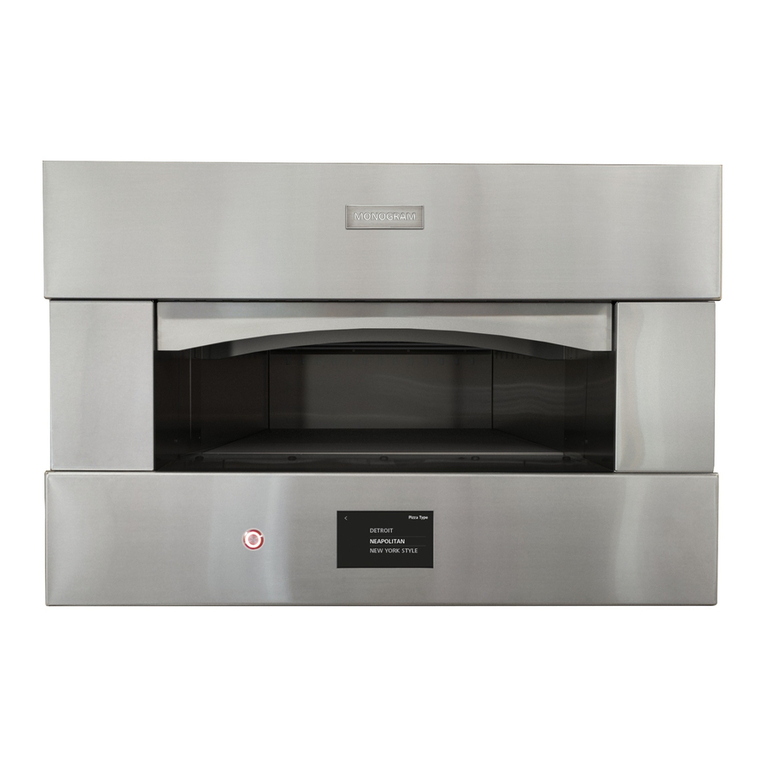Pro-Line Boats VS-D4 User manual

VS-D4
User Manual
DOMESTIC
CHAMBER
VACUUM
SEALER

Congratulations on your purchase
of a Pro-line Chamber Vacuum Sealer.
Note: Please read through the instructions carefully before using or installing the product and ensure that the
manual is kept in a safe place for future reference.
The system must be properly installed and located in accordance with the installation instructions before it is used.
During the set up of this product if you have any questions, comments or issues DO NOT RETURN TO STORE.
FOR SERVICE AND TECHNICAL ADVICE VISIT WWW.PROLINEAUSTRALIA.COM.AU/CONTACT
Electrical Requirements:
Australia / New Zealand 220-240V 50/60Hz
Due to manufacturing alterations product may
vary slightly from that pictured.
Pro-line Australia
PO Box 4187
Norwood South LPO
South Australia 5067
Email: info@prolineaustralia.com.au
Web: www.prolineaustralia.com.au
Find us
/prolineaustralia
/proline_australia
/proline_australia

INSTALLATION AND OPERATING INSTRUCTIONS 3
• All components need to be installed in accordance with the
user manual instructions for correct performance of unit.
READ ALL INSTRUCTIONS CAREFULLY BEFORE OPERATION OF THE UNIT
• This appliance is not intended for use by persons (including
children) with reduced physical, sensory or mental capabilities,
or lack of experience and knowledge, unless they have
been given supervision or instruction concerning use of the
appliance by a person responsible for their safety.
• Children should be supervised to ensure they do not play with
the appliance.
• Remove and safely discard any packaging material and
promotional labels before using the Vacuum Sealer for the
first time.
• Do not operate any appliance with a damaged cord or plug
or after the appliance malfunctions, or has been damaged in
any manner.
• If the supply cord is damaged, it must be replaced by the
manufacturer, its service agent or similarly qualified persons
in order to avoid a hazard.
• Do not pull or carry the Vacuum Sealer by the cord.
• To protect against risk electric shock and personal injury,
do not immerse cord, plugs, or appliance in water or
other liquids.
• Fully unwind the power cord before use. Connect only to
220V/240V power outlet.
• This appliance should be used in conjunction with
a safety switch.
• Position the appliance at a minimum distance of 20cm away
from walls, curtains and other heat or steam sensitive
materials and provide adequate space above and on all sides
for air circulation.
• Switch unit off and unplug from wall outlet when not in use
and before cleaning.
• Do not use attachments not recommended or sold by the
manufacturer as it may lead to fire, electric shock or injury.
• Operate unit on a stable level flat surface, keep away from
moving parts. Ensure surface is clean and free from water etc.
• Do not place the unit near the edge of a bench or table
during operation.
• Do not place the unit near an oven, heater, direct sunlight or
any other heat source.
OPERATION CONDITIONS & SAFETY PRECAUTIONS

4 INSTALLATION AND OPERATING INSTRUCTIONS
• If an extension cord is used with this unit, the extension cord
must have a rating equal to the rating of this appliance.
• When disconnecting cord, to avoid injury, unplug by grasping
the plug and not the cord and ensure your hands are dry.
• Appliance does not require or use any lubricants, such as
lubricating oils or water.
• Do not use outdoors or on wet surfaces.
• Do not use appliance for other than intended purpose.
• Clean the Vacuum Sealer Lower Gaskets, Sealing Strip, Sealing
Profile and Vacuum Chamber regularly. Also ensure these parts
are cleaned immediately after handling raw meat, poultry or fish.
• Do not reuse the Vacuum Sealer bags after using with raw
meat, fish or poultry or after the bag has been heated, i.e.
microwave or simmer.
• Keep the Vacuum Sealer bags away from babies and children
to eliminate a choking and suffocation hazard.
• Do not leave the Vacuum Sealer unattended when in use.
• Keep the appliance clean. Follow the cleaning instructions
provided in this Instruction book.
• Before cleaning, always turn the appliance OFF, switch off at
the power outlet, unplug at the power outlet and remove the
power cord, if detachable, from the appliance and allow all
parts to cool.
• After use of the Food Vacuum, leave machine cover open for
unit to cool down before closing cover.
• Use only Vacuum Sealer bags/rolls or specially designed
vacuum bags with this appliance.
WARNING:
BURN HAZARD.
Sealing profile will be hot after use, allow
profile to cool before touching.
System Specifications Vacuum Sealer Chamber
Model Code VS-D4
Product Dimensions W 345 X L 285 X H 225
Product Weight 8.5KG
Power 220-240V ~ 50/60Hz, 300W
Max vacuum pressure -0.95 Bar Max.
Air extraction volume 70 Litres / MIN

INSTALLATION AND OPERATING INSTRUCTIONS 5
1.
Control panel
2.
Gasket
3.
Sealing Strip
4.
Sealing Profile
5.
Bag Holder
6.
Air Intake
7.
Power Switch (at rear)
8.
Carry Handles
VACUUM SEALER PARTS IDENTIFICATION
1
2
6
8
3
4
5

6 INSTALLATION AND OPERATING INSTRUCTIONS
CONTROL PANEL
1. Vacuum & Seal
2. Manual Seal
3. Vacuum Time Screen
4. Seal Time Screen
5. Set Time
6. Increase Time
7. Decrease Time
8. Cancel
9. Marinate
10. Vacuum Pressure Gauge
1 2 98
76510
3 4

INSTALLATION AND OPERATING INSTRUCTIONS 7
Ref Description
1. Vacuum & Seal
In stand-by mode, pressing this button starts the automatic vacuum
operation then automatically seals the bag when vacuum is complete.
2. Manual Seal
This button provides two functions:
1. To seal the open end of a bag, used to make a bag from a roll.
NOTE:
the machine will vacuum for about 7 seconds to keep the
tightness of the sealing strip before it seals the bag.
2. When the ‘Vacuum & Seal’ function is in operation pressing this
button stops the vacuum pump and immediately starts to seal the bag.
This can be used to avoid crushing of delicate items.
3. Vacuum Time Screen:
Shows the set vacuum time and the progress of vacuuming process.
4. Seal Time Screen:
Shows the set sealing time and the progress of the sealing process.
Ref Description
5. Set Time:
Press to set the vacuum time and or sealing times and to scroll
between Vacuum Time Screen and Seal Time Screen.
Vacuum time range: 15-60 seconds.
Sealing time range: 3-9 seconds.
6. Increase Time:
Press to increase the vacuum times or sealing times.
7. Decrease Time:
Press to decrease the vacuum times or sealing times.
8. Cancel:
While in operation pressing this button stops the vacuuming or
sealing function.
9. Marinate:
Starts the marinating process. Vacuums for 60 seconds and
does not seal.
10. Vacuum Pressure Gauge
Indicates the pressure in the sealing chamber.
CONTROL PANEL DESCRIPTION

8 INSTALLATION AND OPERATING INSTRUCTIONS
STORING FOOD IN VACUUM BAGS
1. Fully unwind the power cord and connect to power outlet.
2. Switch the Vacuum Sealer Chamber machine on via rear
power switch.
3. Place items for storage into a bag. Clean and straighten the
open end of the bag.
Note:
Do not overload the bag, always allow enough space at the
open end of the bag to be properly placed over the sealing profile.
4. Open the top cover of the unit and lift up the bag holder.
5. Lay the bag into the chamber, ensuring the open end is fully
covering the sealing profile. Use your hands to gently expel any
extra air inside the bag, this will ensure a better result.
See Fig 1
OPERATING INSTRUCTIONS Fig 1

INSTALLATION AND OPERATING INSTRUCTIONS 9
Note:
Ensure no items or food is covering the sealing profile and
that the bag has no wrinkles as it will inhibit the seal.
6. Push down the bag holder making sure the entire opening of
bag is underneath it.
7. Shut the cover and check the vacuum and sealing time suits
the type of food and bag you are using. Adjust if necessary.
8. Press Vacuum & Seal button. The unit will start to vacuum and
will seal the bag automatically. The vacuum time screen will
count down to 0 then the sealing time screen will count down
to 0. The vacuum & Sealing and the Sealing indicator LED will
flash when the process is finished.
9. Wait for the vacuum pressure gauge to return to zero before
opening the cover.
WARNING:
BURN HAZARD – Sealing Profile may be hot after
sealing, allow to cool.
10. Before repeating the process wipe out any excess liquid or
food residue from the vacuum chamber.
Note:
This appliance reaches a high vacuum pressure. During use
of this machine keep an eye on the vacuum pressure gauge, if you
want to interrupt the vacuum process before its end time press the
Manual Seal button. It will stop the vacuum process and switch to
sealing.

10 INSTALLATION AND OPERATING INSTRUCTIONS
USING THE MANUAL SEAL BUTTON TO MAKE A BAG
1. Cut the length you require for a bag from the roll, ensuring
the cut is straight.
2. Fully unwind the power cord and connect to power outlet.
3. Switch the Vacuum Sealer Chamber machine on via rear
power switch.
4. Open the top cover of the unit and lift up the bag holder.
5. Lay the bag into the chamber with one end of the bag laying
flat over the sealing profile.
Note:
Ensure that the bag has no wrinkles as it will inhibit the seal.
6. Push down the bag holder making sure the entire opening of
bag is underneath it.
7. Shut the cover and press seal button. The vacuum time screen
flashes 0 and the pump will work for a few seconds then the
sealing time screen will count down to 0. The Sealing indicator
LED will flash when the process is finished.
8. Open the cover and remove the finished bag.
WARNING:
BURN HAZARD – Sealing Profile may be hot after
sealing, allow to cool.
Note:
For best sealing results do not seal one bag after another
continuously to avoid overheating of the sealing element.

INSTALLATION AND OPERATING INSTRUCTIONS 11
MARINATE USING A BAG
1. Fully unwind the power cord and connect to power outlet.
2. Switch the Vacuum Sealer Chamber machine on via rear
power switch.
3. Place items to be marinated and marinate into a bag. Clean
and straighten the open end of the bag.
Note:
Do not overload the bag, always allow enough space at the
open end of the bag to be properly placed over the sealing profile.
4. Open the top cover of the unit and lift up the bag holder.
5. Lay the bag into the chamber, ensuring the open end is fully
covering the sealing profile. Use your hands to gently expel any
extra air inside the bag, this will ensure a better result.
See Fig 1
6. Push down the bag holder making sure the entire opening of
bag is underneath it.
7. Shut the cover and press marinate button. The vacuum time
screen will count down to 0. It will not seal the bag. The
vacuum & Sealing and the Sealing indicator LED will flash
when the process is finished.
See Fig 2
8. Leave the lid closed and repeat step 7 two more times.
9. Open the cover and remove the marinated food.
Fig 1
Fig 2
↓
↓

12 INSTALLATION AND OPERATING INSTRUCTIONS
VACUUM USING CANISTER
1. Place the food and marinade into the Canister.
2. Secure the lid onto the Canister.
Note:
Leave at least 2cm from the top
3. Connect one end of the Vacuum Seal Hose to the Air Intake and
the other end to the Canister Lid. Ensure both connections are
pushed in tightly.
See Fig 1
4. Lower the Glass Lid of the Vacuum Sealer allowing it to rest
on the Vacuum Seal Hose (do not crush the hose). The lid does
not have to be completely closed.
5. Press the Vacuum & Seal button on the control panel for 2
seconds to begin vacuum process.
Note:
To ensure there is no air leaking between the lid and the
canister, use your hand to push down the lid at the beginning of
the vacuum process.
See Fig 2
6. The pump will activate for a few seconds and then release
the Vacuum.
7. When the Vacuum & Seal indicator light turns off, the process
is complete. Immediately remove the Vacuum Seal Hose.
Note:
Canister not included, available for purchase separately from
www.prolineaustralia.com.au/shop
Fig 1
Fig 2
↓

INSTALLATION AND OPERATING INSTRUCTIONS 13
1. Do not overload the bag; leave enough space at the open end
of the bag so that the bag can be easily placed over the Sealing
Profile and in the Vacuum Chamber.
2. To avoid overfilling, always leave at least 5cm of bag material
between bag contents and top of bag. Then leave at least
one additional 2cm of bag material for each time you plan to
reuse bag.
3. Clean and straighten the open end of the bag before sealing.
Make sure nothing is left on the open area of the bag and bag
has no wrinkles or creased lines. Foreign objects or creased
bag may cause difficulty in sealing the bag tightly.
4. Do not vacuum package objects with sharp points like fish
bones and hard shells. Sharp points may penetrate and tear
the bag.
5. Allow appliance to cool down for one minute between each
sealing operation.
6. Clean the Vacuum Chamber and Sealing Profile/Strip after
each vacuuming operation.
Important:
Do not reuse the Vacuum Sealer bags after using with
raw meat, fish or poultry or after the bag has been heated,
ie. microwave or simmer.
The Vacuum Sealer will change the way you purchase
and store food. The Vacuum Sealer removes air from the
specially designed Vacuum Sealer bags to create a
commercial quality vacuum.
The ease and convenience of preserving and extending the
freshness of your food with the Vacuum Sealer will become an
indispensable part of your food preparation.
The Vacuum Sealer removes air from specially designed bags
to extend food freshness up to 5 times longer than conventional
storage methods.
Oxygen and moisture in air causes food to degrade over time, by
removing the air before sealing items airtight the Vacuum Sealer
extends the life of food naturally.
Vacuum Sealing is not intended to replace the refrigeration or
freezing of foods, food should still be refrigerated or frozen if
normally required.
Important:
It is best to Vacuum Seal fresh food, Vacuum Sealing
will not restore or revive food past its prime. Do not consume food
that has gone bad.
FOOD STORAGE/PRESERVATION GUIDELINESHINTS FOR BEST VACUUMING PERFORMANCE

14 INSTALLATION AND OPERATING INSTRUCTIONS
VACUUM TIME SET-UP GUIDE SEALING TIME SET-UP GUIDE
Touch the Vacuum “+” and “-” to increase or decrease vacuum
time. To determine suitable vacuum time for different foods and
itmes, refer to the table below.
Touch the Seal “+” and “-” to increase or decrease vacuum time.
The thickness and materials of a bag, temperature and food types
can affect the sealing time. Refer to the table below to determine
the suitable sealing time.
Applications Examples Set Vacuum
Time (Sec)
General All food types; Meat, Fish,
Hard Cheeses 20
Soft and crushables Potato Chips, Vegetables 15
Regular bag size Bags smaller than
22x25cm 20-25
Large bag size Bulky items and foods;
Bags larger than 30x25cm 20-30
Liquids Soups, Stock, Stews 40-50
Applications Examples Set Vacuum
Time (Sec)
Normal bags Nylon Material, Dry bags
and Room temperature 4
Soft bags PE or OPP bags 3-4
Thin or wet soft bags Wet PE bags or
thin Nylon bags 4-6
Normal bags used
in cold weather or
outdoors
Windy weather or
Room temperature
below 12˚C
6-7
Moist/Wet bags Wet bags or
Moisture inside 7-8
Aluminium or
Paper bags Aluminium or paper bags 8-9

INSTALLATION AND OPERATING INSTRUCTIONS 15
Freezer Conventional
Storage
Pro-line
Vacuum Sealer
Beef, Pork or Lamb 6 months 2-3 years
Minced Meat 4 months 1 year
Poultry 6 months 2-3 years
Fish 6 months 2 years
Soups, Stews, Sauces 3-6 months 1-2 years
Vegetables 8 months 2-3 years
Berries 1-2 months 6-8 months
Fridge Conventional
Storage
Pro-line
Vacuum Sealer
Semi Hard Cheeses (Swiss,
Cheddar) 1-2 weeks 4-8 months
Hard Cheeses (Parmesan) 1-2 weeks 4-8 months
Lettuce, Spinach 3-6 days 2 weeks
Avocado (cut) 1-2 days 5-6 days
Blueberries 3-6 days 2 weeks
Other berries (Black berries,
Strawberries, Raspberries) 1-3 days 1 week
Pantry Conventional
Storage
Pro-line
Vacuum Sealer
Nuts 6 months 2 years
Coffee Beans 6 months 1 year
Rice 6 months 2 years
Flour 6 months 1-2 years
Sugar 6 months 1-2 years
Chips 1-2 weeks 3-6 weeks
Cookies, Crackers 1-2 weeks 3-6 weeks
FOOD PRESERVATION CHART
Note:
Storage preservation chart are estimates only and should be
used as a guide only. The storage life will depend on the original
quality of the foods and the integrity of the packages seal.

16 INSTALLATION AND OPERATING INSTRUCTIONS
• Before Vacuum Sealing, it is necessary to clean your hands,
and all utensils and surfaces to be used for cutting and
Vacuum Sealing foods.
• Refrigerate or freeze perishable foods immediately, if they
have been vacuum sealed do not leave them sitting at room
temperature.
Note:
It may be harmful if you consume foods which have been
left out at room temperature.
• Store dry foods such as nuts, biscuits or cereals, in a cool,
dark dry place.
• Vacuum Sealed bags prevent freezer burn. Foods that thaw
easily should be placed at the back of the freezer where the
temperature is more constant. When thawing foods it is best
to thaw foods in the refrigerator. Never thaw meats, poultry,
fish or dairy at room temperature or in hot water. If thawing
food by microwave, foods should be cooked immediately after
processing to prevent bacteria growth.
• VACUUM SEALER Vacuum Bags and Rolls are MICROWAVE
safe, to microwave cut off one corner of the bag so that steam
can escape and place in microwave.
• VACUUM SEALER Vacuum Bags and Rolls are SIMMER/BOIL
safe. Place bag into pot of boiling water with the top of the
bag above the water for easy removal.
Note:
Bags or rolls are not reusable if they have been
microwaved or simmered/boiled.
• LIQUIDS can be easily Vacuum Sealed. Fill bag with liquid and
avoid overfilling. Always leave at least 5cm of bag material
between bag contents and top of bag.
• Vacuum Sealing FRUITS, for best results pre-freeze cut soft
fruit prior to vacuum sealing. This helps prevent the fruit
from being crushed during the vacuum process.
• VEGETABLES, for best results blanch vegetables in hot water
otherwise they may turn black. Blanch so that vegetables are
still crunchy, then transfer immediately into icy cold water
to cool. Drain and separate into convenient portions then
vacuum seal in bags.
HINTS & TIPS

INSTALLATION AND OPERATING INSTRUCTIONS 17
• Vacuum Sealing POULTRY and whole FISH, for best results
wash poultry and pat dry with a paper towel. Then place foods
between two paper towels inside bag before Vacuum Sealing.
The paper towels helps to absorb excess moisture and juices.
• Vacuum Sealing red MEATS and fish fillets, for best results
pat dry with a paper towel. Then place foods between two
paper towels inside bag before Vacuum Sealing. The paper
towels helps to absorb excess moisture and juices.
Note:
Vacuum Sealing may cause meat to darken. This is due to
the removal of oxygen and does not indicate spoilage.
• The Vacuum Sealer Home Vacuum Sealer can also protect
NON-FOOD ITEMS from oxidation, corrosion and moisture.
Simply store and seal items in a Vacuum Sealer Vacuum Bag
and follow the “Storing Food in a Vacuum Bag” instructions.
• Vacuum Seal items to help keep them dry, and take up
less room for storage. e.g. camping, batteries, important
documents, travelling and emergency equipment.
• Vacuum seal wet paint brushes between paint jobs without
cleaning, it keeps them moist and saves on clean up time.
• The Marinate Function is a great solution for marinating
meats in minutes, not hours, as Vacuum Sealing opens the
pores in foods such as meat, poultry and seafood’s allowing
foods to absorb marinades at a fraction of the time.
• For the busy family, on-the-go meals can be prepared ahead and
Vacuum Sealed in individual servings, and ready to heat anytime.
• Prepare foods in advance for picnics, hikes, camping trips
and barbeques.
•
Make ICE PACKS by sealing water in a bag and then freezing in
your freezer. For use in eskies to keep your food and drinks cold
or for sports injuries.
• Primarily the Vacuum Sealer is used for vacuum sealing,
however you are able to reseal foil based bags such as chip
and biscuit bags using the Manual Seal function.
HINTS & TIPS

18 INSTALLATION AND OPERATING INSTRUCTIONS
It is important to ensure that all parts of your Vacuum Sealer
sealing system are cleaned on a regular basis.
Follow the care and cleaning guidelines below:
1. Always unplug the unit before cleaning.
2. Do not immerse appliance in water or any other liquid.
3. Do not use abrasive cleaners to clean the unit.
4. Wipe the outside of the unit with a damp cloth,
sponge or mild dish soap.
5. Wipe away food residue and water inside or around
components with a paper towel.
6. Dry thoroughly before use.
Cleaning Sealing Profile:
The Sealing Profile is removable. Wipe the teflon tape coating
with a damp cloth or sponge, also wiping where the Sealing
Profile sits in the Vacuum Chamber. Ensure it is completely
dry before installing back into position.
The Gasket is removeable and can be wiped clean with a damp cloth.
IT IS IMPORTANT
that the Gaskets are not out of shape or damaged
in any manner otherwise air tight seal will not be formed with
when cover is closed. Replacement Gaskets can be purchased
from the Pro-line website.
Cleaning Vacuum Bags:
Note:
Do not reuse the Vacuum Sealer bags after using with
raw meat, fish or poultry or after the bag has been heated, ie
microwave or simmer.
1. Wash bag material in warm water with a mild dishwashing soap.
2. Alternatively, bags can be washed on the top rack in your
dishwasher by turning the bag inside out. Stand bags up
so that the washing water can rinse the entire surface.
CLEANING AND MAINTENANCE STORING YOUR VACUUM PRESERVATION SYSTEM

INSTALLATION AND OPERATING INSTRUCTIONS 19
TROUBLE SHOOTING
BEFORE YOU CALL FOR SERVICE PLEASE REVIEW THE TROUBLE SHOOTING TIPS FIRST.
Problem Possible Cause Solution
Nothing happens when I
press the vacuum sealer
1. Power cord not plugged in.
2. Power cord is damaged.
3. Power switch at rear of unit
is not turned on.
1. Make sure the power cord is correctly plugged into the electrical
outlet, and in the “on” position.
2. Check power cord and plug, and make sure they are not damaged
in any way. If damaged, do not use the vacuum sealer.
3. Turn rear power switch to on position.
Air is not removed from the
bag completely
1. The bag has not been placed
correctly inside the Vacuum
Chamber.
2. Debris covering sealing strip
or gasket. Sealing strip or
gaskets may be out of place.
3. Bag may have a hole.
4. Unit cover has not been
closed properly.
1. To seal properly, open end of bag should be resting on the sealing
profile using the bag holder to hold it in place.
2. Check sealing strip beneath the lid and gasket for debris.
Wipe clean and smooth them back into place.
3. To test, seal the bag with some air in it, submerge in water, and
apply pressure. If there are bubbles present, it does indicate a leak
and a new bag should be used.
4. Open cover and re-close the cover. You may need to gently press
on the cover at the start of the vacuuming process.

20 INSTALLATION AND OPERATING INSTRUCTIONS
Problem Possible Cause Solution
Vacuum sealer bag loses
vacuum after being sealed.
1. Bag not sealed properly.
2. Moisture or juices
from foods.
3. Bag has a hole.
1. Wrinkles, crumbs, grease or liquids may cause leaks along the
seal. Reopen bag, wipe the top inside of the bag and smooth it out
along the sealing strip before resealing.
2. Check if there is moisture or juices from the food present within
the bag, if yes, you may need to cut open the bag and reseal it, or
use an entirely new bag.
3. If items with sharp edges, they may have punctured the bag, and
released the vacuum. Cushion sharp edges in the contents of the
bag with paper towels.
Vacuum sealer not sealing
bag properly
1. Sealing strip is too hot.
2. Seal Only function still active
or needs to reset.
1. If the sealing strip over heats and melts the bag, lift the lid and
allow sealing strip to cool for a few minutes.
2. Before re-pressing the “seal only” key, allow the unit to resume
for 15 seconds.
Some spare parts are available for purchase from www.prolineaustralia.com.au/shop
Table of contents
Other Pro-Line Boats Kitchen Appliance manuals
Popular Kitchen Appliance manuals by other brands

Parkinson Cowan
Parkinson Cowan 5000-2 Automatic user manual
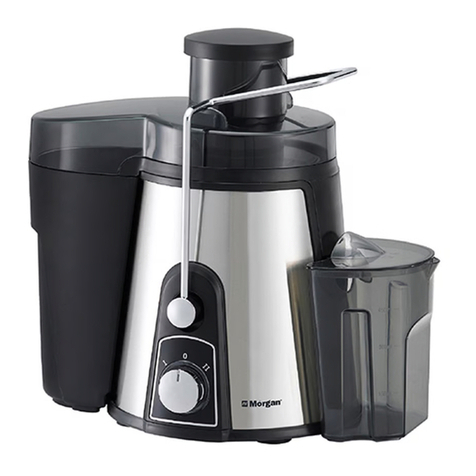
Morgan
Morgan MJE-SC160W user manual

Nonna
Nonna 42273 instruction manual
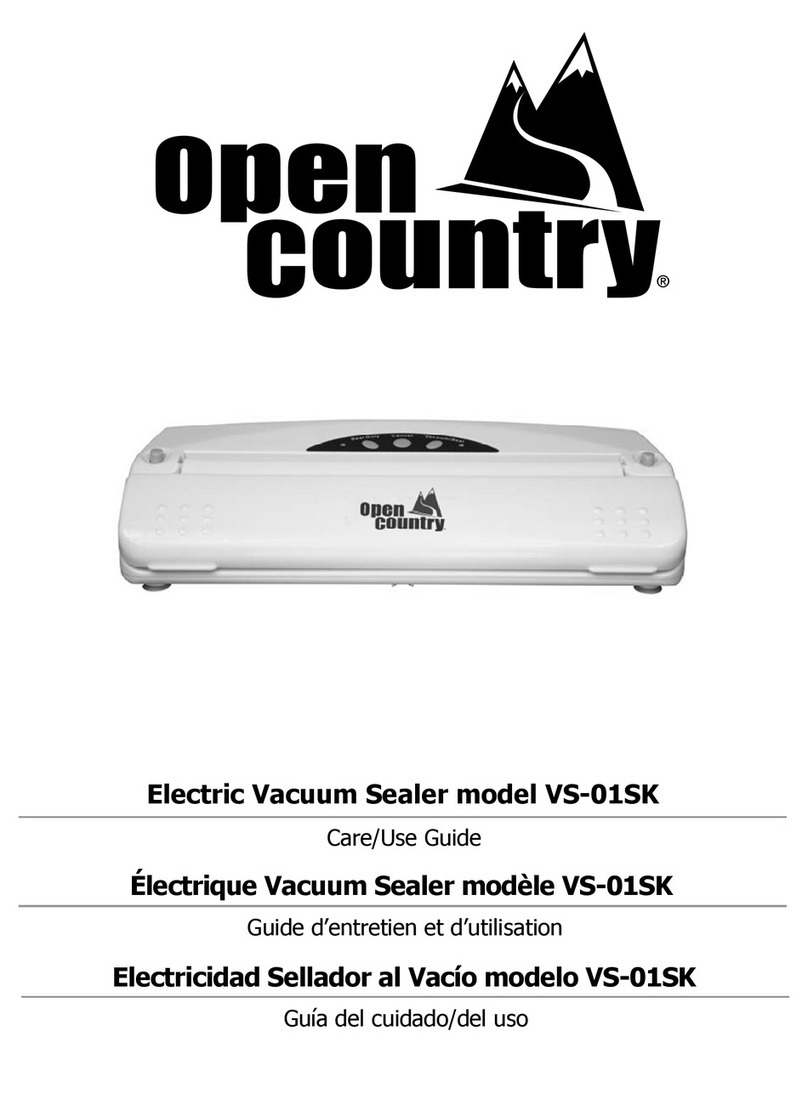
Open Country
Open Country VS-01SK Care/use guide
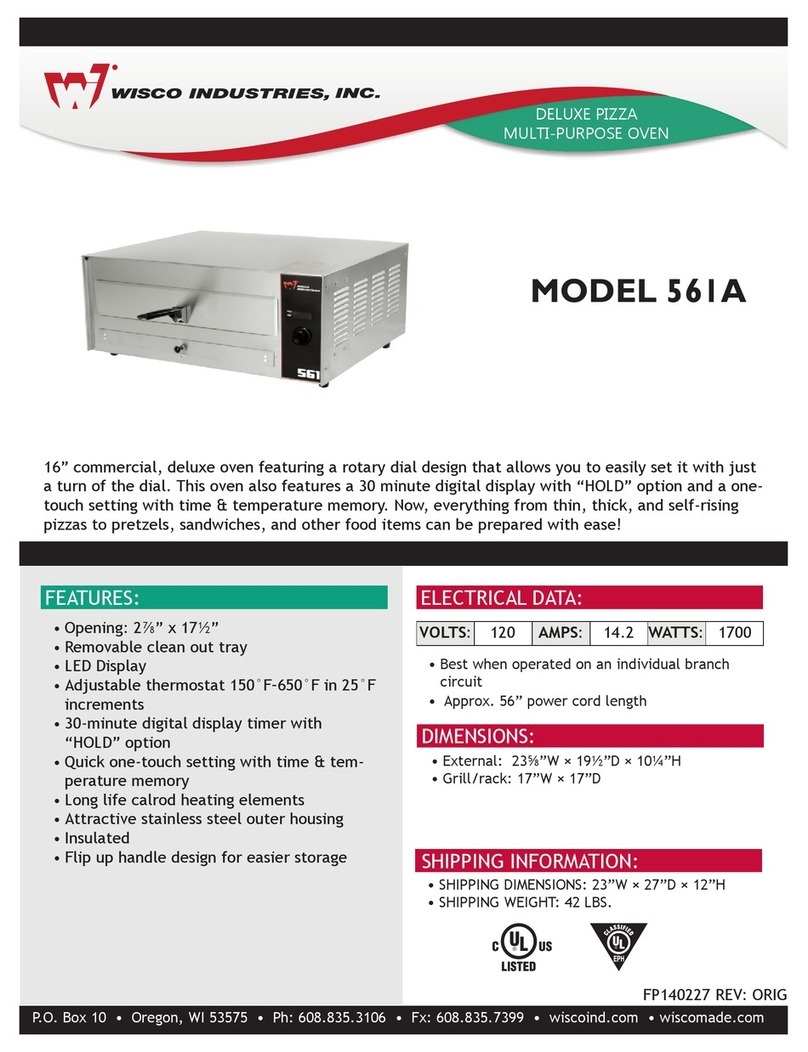
Wisco Industries
Wisco Industries 561A manual
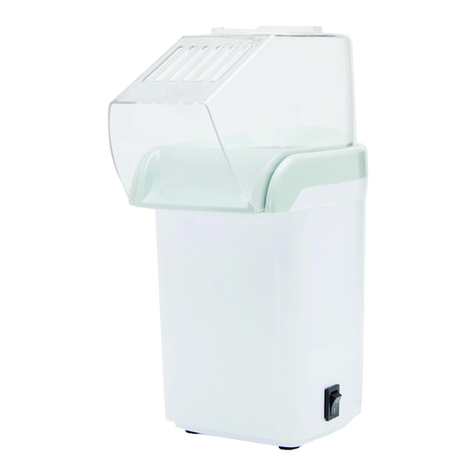
Brentwood Appliances
Brentwood Appliances PC-486W Operating and safety instructions
